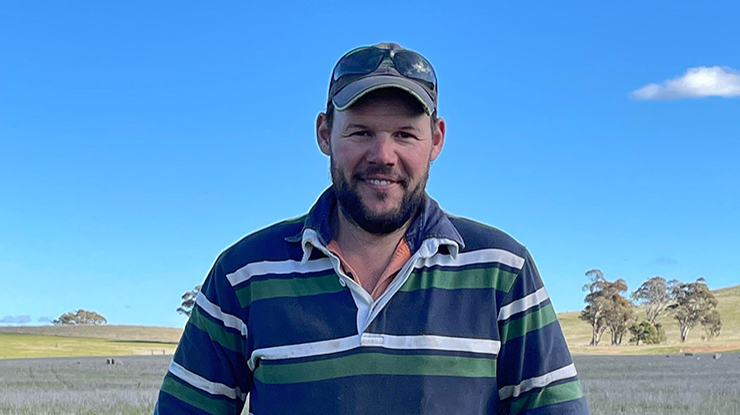
Addressing soil acidity has allowed the Hall family to switch to more productive pasture species and increase their stocking rate on their 3,000ha property near Stawell, Victoria.
By changing soil conditions, especially pH by applying lime, the Halls now have a program which used a cropping rotation to replace cocksfoot and annual based pastures with phalaris.
Mathew (pictured) and his wife Malinda farm in partnership with his parents, Philip and Trudy. They run a mixed grazing and cropping enterprise which includes a self-replacing Merino flock with a portion of ewes joined to terminal sires.
Targeting soils
Mathew was motivated to become involved in his local Healthy Soils Group to learn more about his soils (which include a mix of sandy loams, clay loams and clay rises).
The group covered sessions on clover nodulation and what to look for, soil acidity, soil biology and soil carbon.
"As a result of being involved in the group, I started having a closer look at my pastures and soils, especially the clover content and overall productivity of our pastures," Mathew said.
"It made me appreciate there was the potential to increase our overall productivity by changing our soil conditions, especially pH."
Pasture program
The Halls had been applying lime for the past 15 years as part of their cropping program.
"The pH in our paddocks prior to lime is in the low to mid 4s," Mathew said.
"The first paddock we treated and renovated 15 years ago had been sown down to Porto Cocksfoot on buckshot soils where the pH (CaCl2) was 4.1 before the first application of lime.
"It was time to renovate this pasture again and we decided to move away from cocksfoot and establish phalaris which has greater productivity."
The Halls applied lime at 2.5t/ha for the original establishment of cocksfoot, but when they renovated the pasture five years ago, the pH was around 4.8. They applied another 1.5t/ha with a short cropping program and established Holdfast GT phalaris as the pasture base.
"We're aiming for a soil pH in the low to mid 5s after application, which minimises aluminium toxicity and allows us to change from cocksfoot to phalaris and sub-clover and really increase pasture production," Mathew said.
"Liming to reduce soil acidity is really driving our production."
Improved production
The change in pasture type has coincided with the Halls changing their time of lambing from April to June to take advantage of the improved phalaris growth which is growing a bigger feed wedge in winter for ewes to lamb down on.
"There is such a big improvement in pasture productivity and quality by switching from cocksfoot to phalaris and sub-clover," Mathew said.
"The overall result is our farm is now more productive – in the past 10 years we've doubled our cropping program to 1,100ha while at the same time we've been able to increase our ewe flock numbers by 30% to around 4,500."
Cropping step
The cropping program is a key ingredient in the Halls' pasture improvement recipe.
Their well-planned cropping rotation utilises a combination of spring knockdowns, cereals (grazing, grain and hay), canola, vetch or arrowleaf clover to create the perfect opportunity to control weeds and incorporate lime in the lead up to pasture establishment.
"Once we sow a paddock to a new pasture we really look after it to get it through its first spring," Mathew said.
"When we started applying lime it was a bit daunting but now we're really comfortable with getting lime out to improve soil conditions, and will consider top dressing some established pastures in the future to keep pH at the ideal levels.
"This year we will grid sample a couple of paddocks to look at the potential for applying lime at variable rates."
SEASONAL ACTION PLAN |
1. Access resources to get your pastures performing at their best at mla.com.au/persistent-pastures 2. Learn how to take soil tests at mla.com.au/healthy-soils 3. Reduce competition from weeds to enable pastures to thrive – MLA has tactics to prevent, manage and eliminate problem species at mla.com.au/feedbase-hub/weed-control |






